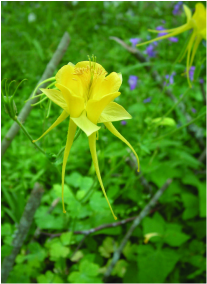Plant of the Month:
Columbine--Aquilegia chrysantha

Columbine is a clump-forming perennial that is grown not only for its flowers, but also for its lacy, green, blue-green or gray-green fern-like foliage. These plants flower during cooler weather during late spring and early summer.
Flowers, up to three inches across, are bell shaped and usually have backward-projecting nectar-bearing spurs. Plants are frost hardy and prefer a sunny location with some shade to protect them from the heat of the summer.
Most Columbines are not long-lived. Allowing spent flowers to form seed will ensure a crop of volunteer seedlings.
Interesting Facts
Aquila is Latin for eagle. This is how the name aquilegia chrysantha derives, as the spurs are said to look like a bird in flight.
Summary
Type: Perennial
Height: 24 to 36 inches
Blooms: Late spring to early summer Spread: 24 inches
Light: Full sun to part shade Water: Average
Hardiness: High
Native: Yes
Wildlife: Yes